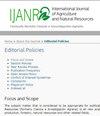Measuring the length of the juvenile phase and corm growth in the Chilean endemic geophyte Conanthera bifolia Ruiz et Pavon
IF 0.5
4区 农林科学
Q3 AGRICULTURE, MULTIDISCIPLINARY
International Journal of Agriculture and Natural Resources
Pub Date : 2023-01-01
DOI:10.7764/ijanr.v50i2.2397
引用次数: 0
Abstract
The geophyte Conanthera bifolia is endemic to Chile and belongs to the family Tecophilaeaceae. When in flower, the plant produces an inflorescence with blue florets. Conanthera plants arise from underground structures called corms; these have been reported to have been consumed as food in the past. These plants also have ornamental potential as garden or pot plants. The new corm starts growing on top of the mother corm by the end of summer; blooming occurs in the spring, and the plant goes dormant after fruit set. The corm flowering size and juvenile phase length in C. bifolia are unknown. The study objective was to determine the weight of the corm that is necessary for flowering and the number of seasons required to reach that weight. Corms were collected from the wild, separated into 10 weight categories from 0.2 to 5 g, and planted in trays in an unheated greenhouse in Talca, Chile. Corms weighing more than 1 g were able to flower, and the greatest flowering (48 to 70%) was found in corms weighing 3.5 to 5 g. The plant propagation coefficient decreased as the initial corm weight increased. The number of seasons to reach flowering size was estimated to be 8 years, placing this species in the group of geophytes with slow growth.测量智利特有地生植物双玉兰(Conanthera bifolia Ruiz et Pavon)幼期长度和球茎生长
地生植物双歧豆属土生植物科,智利特有。开花时,这种植物的花序上开着蓝色的小花。菊科植物生长于地下结构,称为球茎;据报道,在过去,人们曾将它们作为食物食用。这些植物也有作为花园或盆栽的观赏潜力。夏末,新球茎开始在母球茎上生长;春天开花,坐果后休眠。双歧草球茎的开花大小和幼期长度是未知的。研究的目的是确定球茎开花所需的重量以及达到该重量所需的季节数。从野外采集球茎,分为10个重量类别,从0.2到5克不等,种植在智利塔尔卡的一个不加热温室的托盘中。重量大于1克的球茎能够开花,重量为3.5 ~ 5克的球茎开花最多(48 ~ 70%)。植株繁殖系数随初始粒重的增加而降低。达到开花大小的季节数估计为8年,将该物种置于生长缓慢的地植物群中。
本文章由计算机程序翻译,如有差异,请以英文原文为准。
求助全文
约1分钟内获得全文
求助全文
来源期刊

International Journal of Agriculture and Natural Resources
AGRICULTURE, MULTIDISCIPLINARY-
CiteScore
2.40
自引率
0.00%
发文量
0
 求助内容:
求助内容: 应助结果提醒方式:
应助结果提醒方式:


